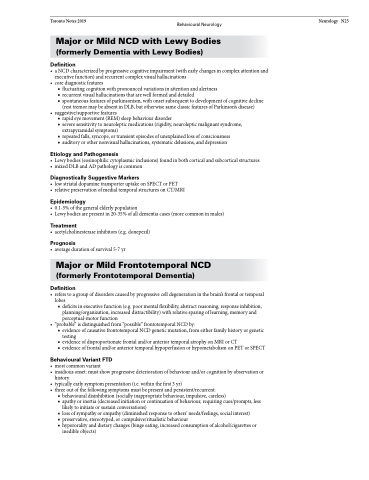Page 767 - TNFlipTest
P. 767
Toronto Notes 2019 Behavioural Neurology Neurology N25 Major or Mild NCD with Lewy Bodies
(formerly Dementia with Lewy Bodies)
Definition
• aNCDcharacterizedbyprogressivecognitiveimpairment(withearlychangesincomplexattentionand executive function) and recurrent complex visual hallucinations
• corediagnosticfeatures
■ fluctuating cognition with pronounced variations in attention and alertness
■ recurrent visual hallucinations that are well formed and detailed
■ spontaneous features of parkinsonism, with onset subsequent to development of cognitive decline
(rest tremor may be absent in DLB, but otherwise same classic features of Parkinson’s disease)
• suggestive/supportivefeatures
■ rapid eye movement (REM) sleep behaviour disorder
■ severe sensitivity to neuroleptic medications (rigidity, neuroleptic malignant syndrome,
extrapyramidal symptoms)
■ repeated falls, syncope, or transient episodes of unexplained loss of consciousness
■ auditory or other nonvisual hallucinations, systematic delusions, and depression
Etiology and Pathogenesis
• Lewybodies(eosinophiliccytoplasmicinclusions)foundinbothcorticalandsubcorticalstructures • mixedDLBandADpathologyiscommon
Diagnostically Suggestive Markers
• lowstriataldopaminetransporteruptakeonSPECTorPET
• relativepreservationofmedialtemporalstructuresonCT/MRI
Epidemiology
• 0.1-5%ofthegeneralelderlypopulation
• Lewybodiesarepresentin20-35%ofalldementiacases(morecommoninmales)
Treatment
• acetylcholinesteraseinhibitors(e.g.donepezil)
Prognosis
• averagedurationofsurvival5-7yr
Major or Mild Frontotemporal NCD (formerly Frontotemporal Dementia)
Definition
• referstoagroupofdisorderscausedbyprogressivecelldegenerationinthebrain’sfrontalortemporal lobes
■ deficits in executive function (e.g. poor mental flexibility, abstract reasoning, response inhibition, planning/organization, increased distractibility) with relative sparing of learning, memory and perceptual-motor function
• “probable”isdistinguishedfrom“possible”frontotemporalNCDby:
■ evidence of causative frontotemporal NCD genetic mutation, from either family history or genetic
testing
■ evidence of disproportionate frontal and/or anterior temporal atrophy on MRI or CT
■ evidence of frontal and/or anterior temporal hypoperfusion or hypometabolism on PET or SPECT
Behavioural Variant FTD
• mostcommonvariant
• insidiousonset:mustshowprogressivedeteriorationofbehaviourand/orcognitionbyobservationor
history
• typicallyearlysymptompresentation(i.e.withinthefirst3yr)
• threeoutofthefollowingsymptomsmustbepresentandpersistent/recurrent:
■ behavioural disinhibition (socially inappropriate behaviour, impulsive, careless)
■ apathy or inertia (decreased initiation or continuation of behaviour, requiring cues/prompts, less
likely to initiate or sustain conversations)
■ loss of sympathy or empathy (diminished response to others’ needs/feelings, social interest)
■ preservative, stereotyped, or compulsive/ritualistic behaviour
■ hyperorality and dietary changes (binge eating, increased consumption of alcohol/cigarettes or
inedible objects)


